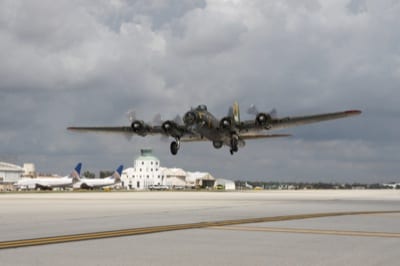 Completing the restoration of a vintage aircraft to airworthy status is always a cause for celebration, especially when the plane is one of only a handful of B-17s in the world. No one knows this better than the members of the Gulf Coast Wing of the Commemorative Air Force, who have been laboring on the B-17 “Texas Raiders” for the better part of seven and a half years. The G-model Flying Fortress returned to the skies Oct. 14 at Houston Hobby Airport (KHOU).
Completing the restoration of a vintage aircraft to airworthy status is always a cause for celebration, especially when the plane is one of only a handful of B-17s in the world. No one knows this better than the members of the Gulf Coast Wing of the Commemorative Air Force, who have been laboring on the B-17 “Texas Raiders” for the better part of seven and a half years. The G-model Flying Fortress returned to the skies Oct. 14 at Houston Hobby Airport (KHOU).
The B-17 is perhaps the most well-known heavy aircraft from World War II. Declared surplus after the war, the bomber was sold to the civilian market. The CAF acquired it in 1967.
It has undergone several restorations, notes Gulf Coast Public Information Officer Col. Sandra Thompson. “The latest restoration effort began in early 2002, when the FAA issued an Airworthiness Directive to inspect the wing spars and surrounding structures on the B-17,” she said. “The inspection found defective wing spars and terminal end fittings.”
Adding to the bomber’s issues was the fact the airplane has spent most of its life in the humid Gulf Coast region and the salt air had exacerbated corrosion.
Prior to the spar AD, the main focus of the Gulf Coast wing was finding a permanent hangar for the B-17.
“With a wing span of 103 feet, 9.37 inches and a vertical stabilizer at 19 feet, 2.44 inches, Texas Raiders needs a fairly large hangar,” says Thompson, who notes the wing pays $4,350 a month rent for the lease at Hobby Airport, “which is difficult since we have no income currently aside from public donations.”
Wing officials are looking for hangar space to house the B-17, as well as provide maintenance supply storage and working space, a public welcoming space for processing rides, and a potential small museum space with climate control for the World War II artifacts collected over the past 40 years. “Currently we house these rare and fragile items in members’ cedar closets and air-conditioned storage spaces away from our current non-air-conditioned hangar,” she said.
Before the restoration work began, the group had a $250,000 growing fund for the purpose of securing shelter for the corrosion-battle-weary bomber, but those funds were consumed by the restoration effort, Thompson said.
Not only did the group have to pay for parts to be rebuilt or fabricated, they also had to move the behemoth aircraft twice as leases on temporary hangar space ran out. In November 2008 the hangar situation was especially grim for for the B-17.
“With no hangar space available, a call for help to the Houston community was made through a press conference,” Thompson recalled. “The CAF, recognizing the essential need of this $3 million aircraft, announced the options that we either find a hangar or disassemble the aircraft and move it to a location, perhaps out of the Houston area, where effective restoration could be conducted.”
Million Air at Hobby Airport offered to share space on the west side of the airport, she said, noting this was the last across-the-airport move for the B-17. It still resides in that space as the cosmetic touches are being applied to the airplane.
When the cosmetic work is completed, the B-17 will return to the skies providing revenue rides. At several hundred dollars a pop, they help the CAF pay the expenses.
“We hope to begin a touring schedule, which will encompass weekends and some mid-week static and flying tour stops,” says Thompson.
The CAF has to spend money to make money, Thompson said, adding that operating a B-17 is not cheap despite the fact that the pilots and ground crews are all volunteers. Thompson estimates the B-17 costs $2,500 an hour to operate.
For more information: GulfCoastWing.org
